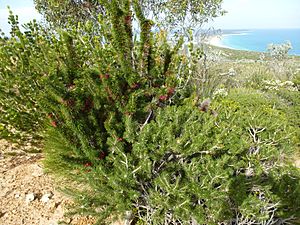Dense clawflower facts for kids
Quick facts for kids Dense clawflower |
|
|---|---|
 |
|
| C. pinifolius at East Mount Barren | |
| Scientific classification | |
| Genus: |
Calothamnus
|
| Species: |
pinifolius
|
| Synonyms | |
|
Melaleuca peucophylla Craven & R.D.Edwards |
|
Calothamnus pinifolius, often called the dense clawflower, is a special plant. It belongs to the myrtle family, called Myrtaceae. This plant grows only in the southwest part of Western Australia. It is a tall bush with many leaves. It has clusters of red flowers that bloom between July and January. These flowers are often partly hidden by the plant's spiky leaves.
Contents
What Does the Dense Clawflower Look Like?
The dense clawflower is a straight-growing bush. It can grow from about 0.3 to 2.0 meters (1 to 7 feet) tall. It has a few long stems and branches. Shorter shoots grow from above the leaves on the longer stems. Its leaves are about 20 to 30 millimeters (0.8 to 1.2 inches) long. They are packed closely together, thin, and feel a bit prickly.
The flowers grow in thick groups. They are usually partly hidden by the leaves. Each flower has four sepals (small leaf-like parts that protect the bud). It also has four petals (the colorful parts of the flower). There are also four claw-like groups of stamens. Stamens are the parts that make pollen. These stamen groups are about 25 millimeters (1 inch) long. The plant flowers from July to January. After flowering, it grows woody capsules. These are like small seed pods. They have two noticeable, curved parts.
How Did It Get Its Name?
The plant Calothamnus pinifolius was first officially described in 1863. This was done by Ferdinand von Mueller. He was a government botanist in Victoria. He wrote about it in his book Fragmenta Phytographiae Australiae.
The plant's specific name, pinifolius, comes from two Latin words. Pinus means "pine" and folium means "leaf". So, its name means "pine-leaved". This is because its leaves look a bit like pine needles. In 2014, some scientists suggested renaming this plant Melaleuca peucophylla.
Where Does the Dense Clawflower Grow?
The dense clawflower is found in the Mount Barren Range. This area is part of the Esperance Plains region. It grows on hillsides in thick scrubland. It prefers rocky soils that come from laterite and quartzite.
Images for kids
-
C. pinifolius (cultivated) in the Royal Botanic Gardens, Cranbourne




